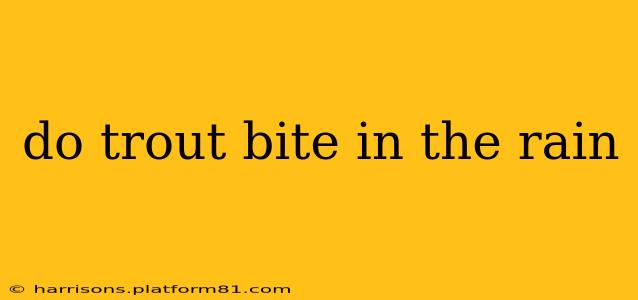The question of whether trout bite in the rain is a classic debate among anglers. The simple answer is: sometimes, yes! But the reality is far more nuanced than a simple yes or no. Rain significantly impacts trout behavior, and understanding these changes is key to successful fishing in wet conditions. This guide delves into the factors influencing trout activity during rainfall, helping you maximize your chances of a successful rainy day fishing trip.
What Happens to Trout When it Rains?
Rain dramatically alters the fishing environment. The increased water flow affects water clarity, temperature, and insect activity—all crucial elements impacting trout feeding habits. Heavier rainfall can also lead to increased runoff, carrying sediment and debris into the water, further impacting visibility.
How Does Rain Affect Water Clarity?
Increased water flow stirs up the bottom, reducing water clarity. This can make it harder for trout to spot prey, potentially reducing their feeding activity. However, in some cases, slightly muddy water can actually improve fishing, as the murkiness provides cover for trout pursuing prey.
Does Rain Affect Water Temperature?
Rainwater is typically cooler than the water already in the river or stream. This sudden temperature drop can temporarily suppress trout's metabolism and feeding activity. However, this effect is often short-lived, and as the water mixes, the temperature stabilizes.
How Does Rain Impact Insect Activity?
Rain can flush terrestrial insects—like ants, beetles, and grasshoppers—into the water, providing an abundant food source for trout. This influx of insects can trigger a feeding frenzy, making rainy days surprisingly productive.
Do Trout Bite Better in Light Rain or Heavy Rain?
The intensity of the rain plays a crucial role. Light to moderate rain often produces the best results. The increased insect activity outweighs the negative impacts of slightly reduced visibility. Heavy downpours, on the other hand, can significantly reduce trout activity due to poor visibility, turbulent water, and the potential for significant temperature drops.
What are the Best Lures and Techniques for Rainy Day Trout Fishing?
Choosing the right gear is essential for rainy day success. Here's what to consider:
- Lures: Consider darker colored lures and streamers that are more easily visible in murky water. Nymphs and wet flies mimicking the terrestrial insects washed into the stream can also be highly effective.
- Techniques: Focus on areas with cover, such as undercut banks or submerged logs, where trout can find refuge from the current and still ambush prey. Slow, methodical retrieves often work best in less clear water.
What Time of Day is Best for Trout Fishing in the Rain?
While the impact of rain varies, many anglers find the hours immediately following a rain shower to be particularly productive. This is because the water has begun to clear slightly, and the influx of insects remains high.
What are the Best Types of Weather for Trout Fishing?
While overcast conditions without rain can also provide excellent fishing, the presence of some rain, especially light to moderate rainfall, can be very effective. The key factor is understanding the impacts of rain on water clarity, temperature, and insect activity.
Conclusion
Rain doesn't automatically mean a fishing trip is doomed. Understanding how rain affects trout behavior, choosing the right gear, and employing appropriate techniques can significantly increase your chances of success even in less-than-ideal weather conditions. Remember to always check weather forecasts and adapt your approach based on the intensity and duration of rainfall. Happy fishing!
